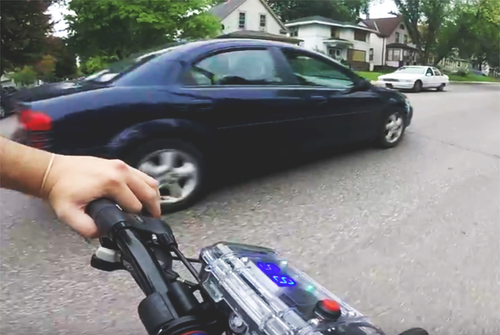
Transportation infrastructure that encourages bicycling without interfering with traffic flow or exceeding budgets is a key issue for many state and local governments. Ensuring the safety of bicyclists is a central part of this challenge.
University of Minnesota graduate students Josh Pansch, Isaac Evans and Lila Singer-Berk studied the factors that affect vehicle passing distance (VPD) on different bicycle facilities across Hennepin County. They were supervised by Greg Lindsey, professor at the Humphrey School of Public Affairs and Center for Transportation Studies Roadway Safety Institute scholar.
In a study published in ITE Journal, the team examined vehicular encroachment using Hennepin County’s C3FT bike-mounted radar and a GoPro video camera. The researchers captured nearly 3,000 passing events to determine rates of vehicular encroachment—when a vehicle fails to meet the minimum three-foot VPD required by Minnesota statute—on different types of roadways with different facilities.
“In our study, VPD was our basic form of analysis we used to measure how many inches away a passing vehicle was from our bicycle,” said Evans. “We also used VPD to derive our second variable, which was an encroachment.”
Researchers studied five different bicycle facilities: buffered bike lane (painted), protected (bollard) bike lane, no facility, shoulder, standard bike lane and bike boulevard. The safest facilities being the bollard bike lane.
“The bike boulevard was the highest likely to have an encroachment,” said Evans. “This is because encroachment can occur in both directions. It is almost a one-lane road with parking on each side and we would have a car encroach coming towards us.”
According to the research team, these findings confirm that road design and traffic planning decisions affect how vehicles and cyclists interact.
"The results of this study provide evidence that investments in these types of bike facilities may reduce potentially risky interactions between vehicles and cyclists,” said Lindsey. “Other public works departments that are working to reduce risk and implement safety-related programs like Vision Zero and Safe Routes to School can use these findings to help prioritize investments.”
Other key findings include:
-
The overall encroachment rate was low. Of the total 33 encroachments measured, 64 percent occurred on the road with no bicycle facility, giving it the highest encroachment rate of about 5.7 percent. All other roads had encroachment rates of less than or near one percent.
-
VPD was greatest on the bollard bike lane and lowest on the roads with no facility and the standard bike lane. Protected or buffered bicycle facilities are best at reducing VPD and the rate of encroachment, but bike lanes and wide shoulders also reduce the likelihood of encroachment.
-
Excluding facility type, the presence of an adjacent vehicle played the largest role in reducing VPD.
Partial funding was provided by Hennepin County. The University of Minnesota, Humphrey School of Public Affairs provided additional, in-kind support.
About the Humphrey School of Public Affairs
The Humphrey School of Public Affairs at the University of Minnesota ranks among the country’s top 10 professional public policy and planning schools. The School is long noted for equipping students to play key roles in public life at the local, state, national, and global levels and offers six distinctive master’s degrees, a doctoral degree, and six certificate programs. Learn more at hhh.umn.edu.
- Categories:
- Science and Technology





